The AMD Ryzen Threadripper 1950X and 1920X Review: CPUs on Steroids
by Ian Cutress on August 10, 2017 9:00 AM ESTGrand Theft Auto
The highly anticipated iteration of the Grand Theft Auto franchise hit the shelves on April 14th 2015, with both AMD and NVIDIA in tow to help optimize the title. GTA doesn’t provide graphical presets, but opens up the options to users and extends the boundaries by pushing even the hardest systems to the limit using Rockstar’s Advanced Game Engine under DirectX 11. Whether the user is flying high in the mountains with long draw distances or dealing with assorted trash in the city, when cranked up to maximum it creates stunning visuals but hard work for both the CPU and the GPU.
For our test we have scripted a version of the in-game benchmark. The in-game benchmark consists of five scenarios: four short panning shots with varying lighting and weather effects, and a fifth action sequence that lasts around 90 seconds. We use only the final part of the benchmark, which combines a flight scene in a jet followed by an inner city drive-by through several intersections followed by ramming a tanker that explodes, causing other cars to explode as well. This is a mix of distance rendering followed by a detailed near-rendering action sequence, and the title thankfully spits out frame time data.
There are no presets for the graphics options on GTA, allowing the user to adjust options such as population density and distance scaling on sliders, but others such as texture/shadow/shader/water quality from Low to Very High. Other options include MSAA, soft shadows, post effects, shadow resolution and extended draw distance options. There is a handy option at the top which shows how much video memory the options are expected to consume, with obvious repercussions if a user requests more video memory than is present on the card (although there’s no obvious indication if you have a low-end GPU with lots of GPU memory, like an R7 240 4GB).
To that end, we run the benchmark at 1920x1080 using an average of Very High on the settings, and also at 4K using High on most of them. We take the average results of four runs, reporting frame rate averages, 99th percentiles, and our time under analysis.
All of our benchmark results can also be found in our benchmark engine, Bench.
MSI GTX 1080 Gaming 8G Performance
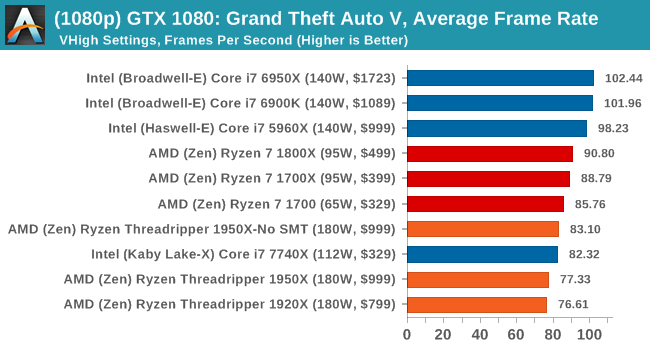
1080p

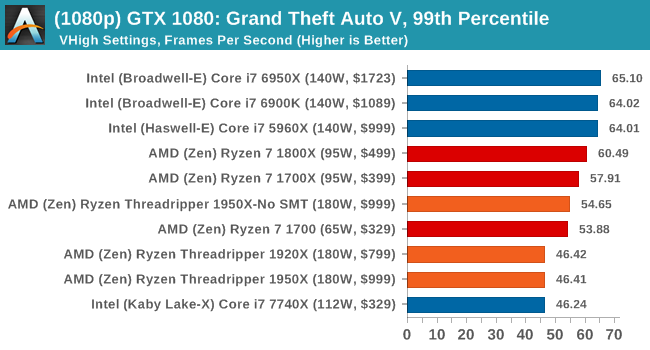
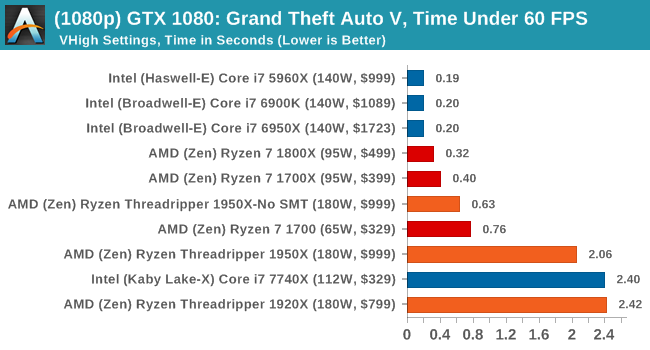
4K

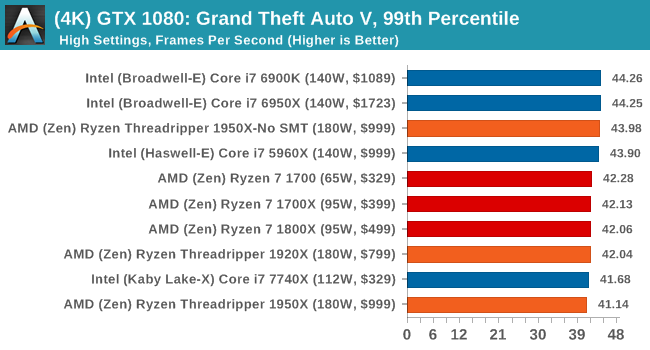

ASUS GTX 1060 Strix 6G Performance
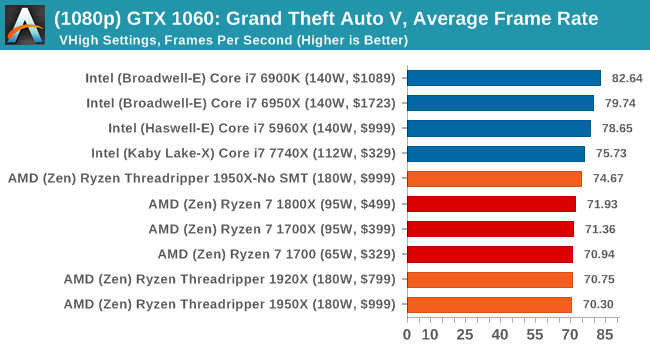
1080p

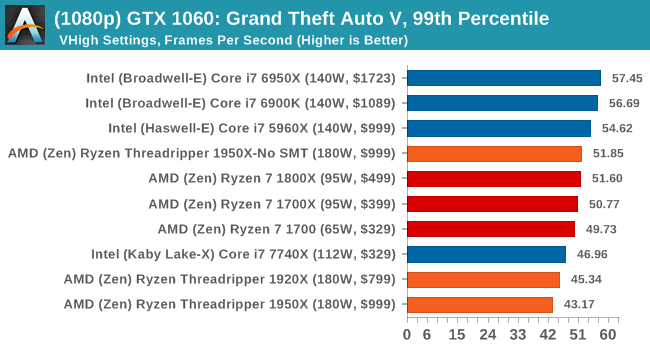
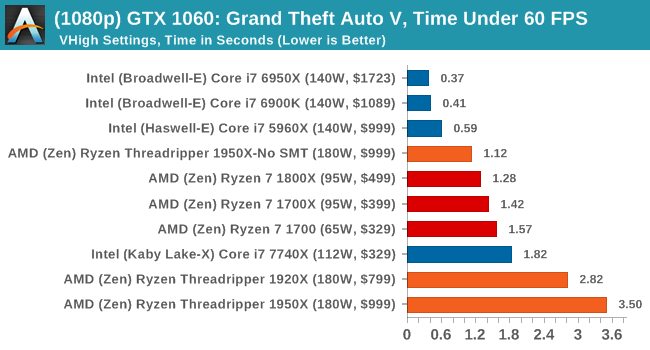
4K

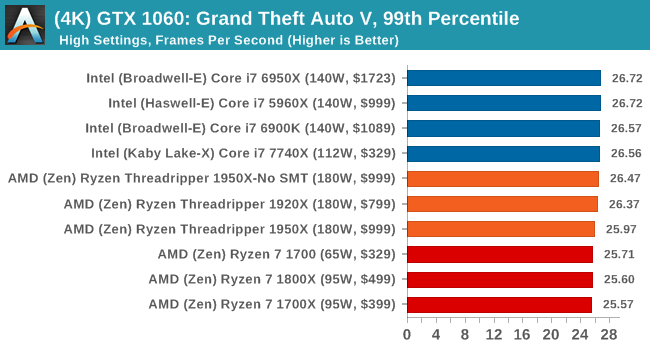
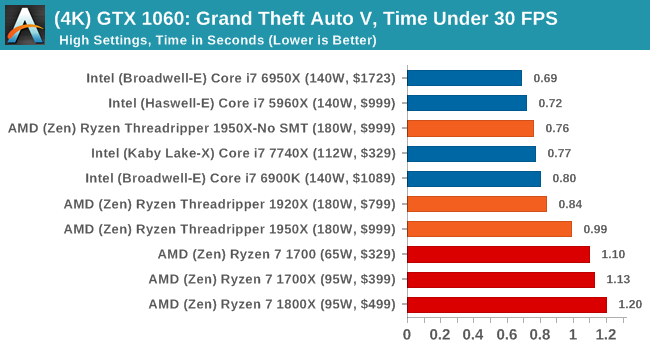
Sapphire Nitro R9 Fury 4G Performance
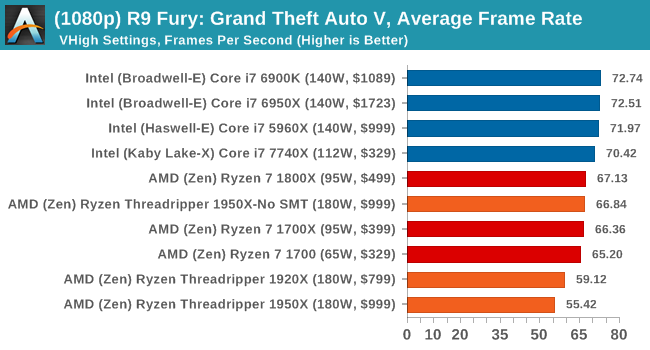
1080p

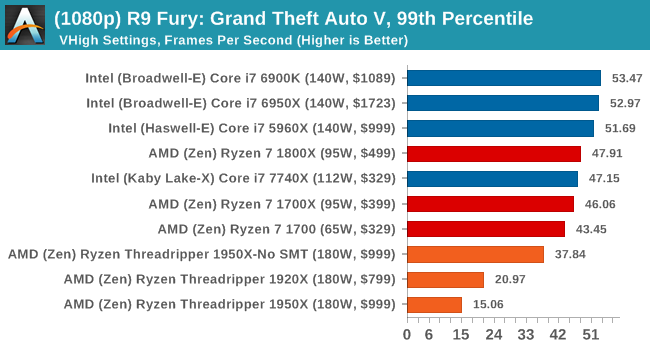
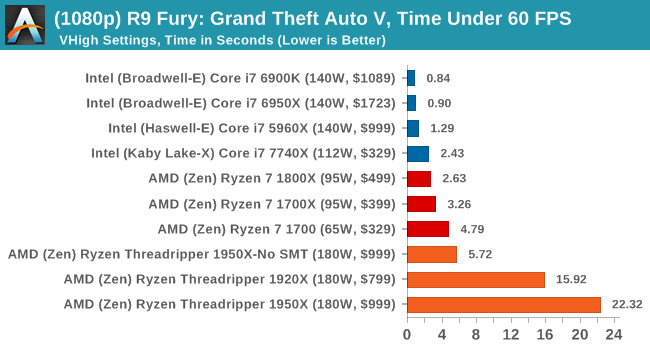
4K
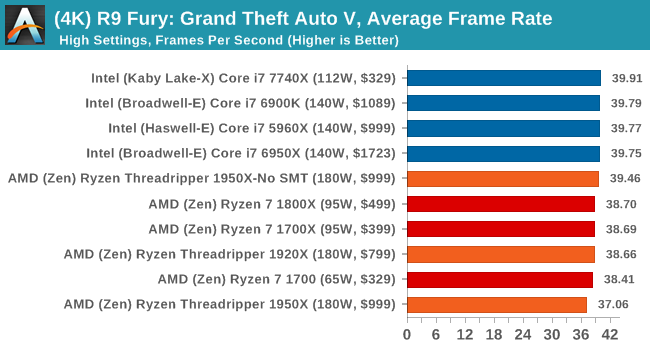
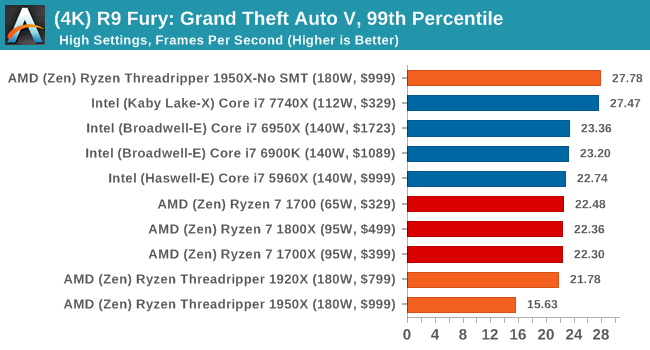
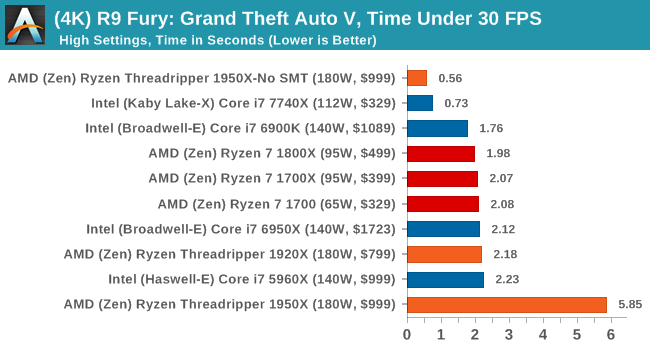
Sapphire Nitro RX 480 8G Performance
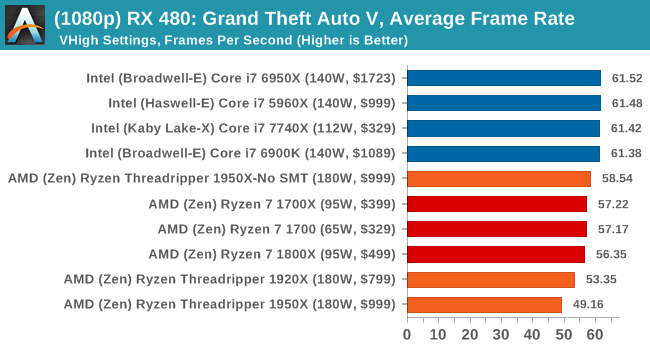
1080p

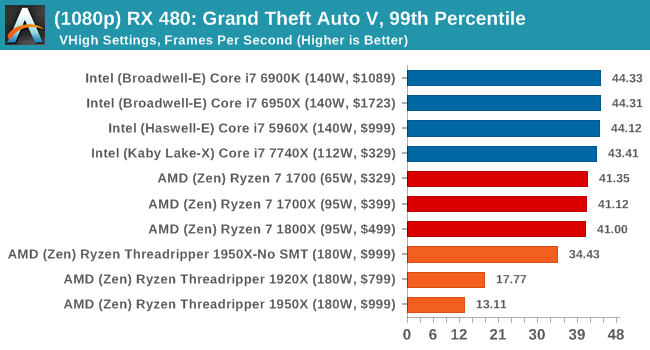
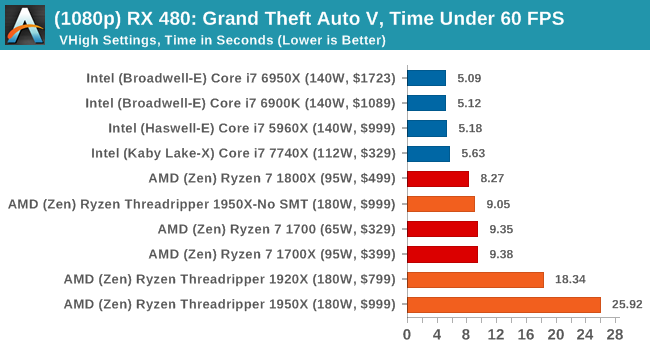
4K
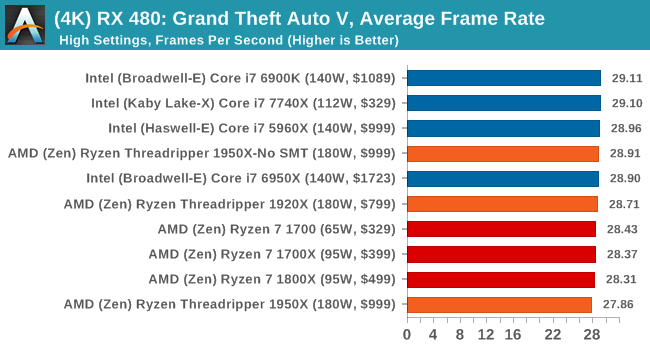
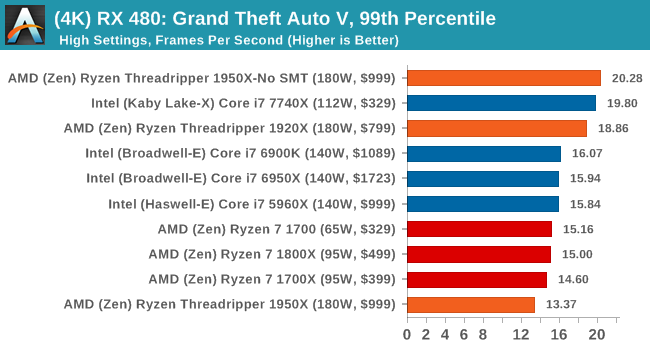
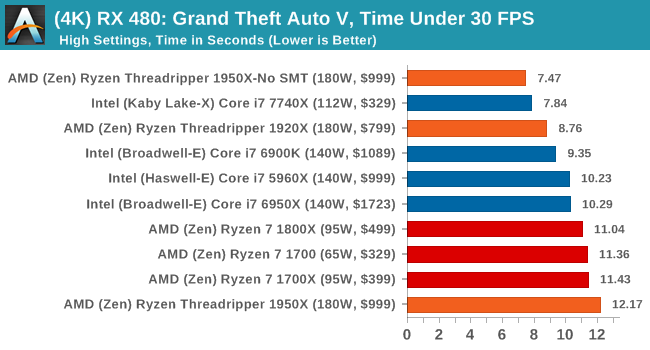
Depending on the CPU, for the most part Threadripper performs near to Ryzen or just below it.













347 Comments
View All Comments
NikosD - Sunday, August 13, 2017 - link
Well, reading the whole review today - 13/08/2017 - I can see that the reviewer did something more evil than not using DDR4-3200 to give us performance numbers.He used DDR4-2400, as he clearly states in the configuration table, filling up the performance tables BUT in the power consumption page he added DDR4-3200 results (!) just to inform us that DDR4-3200 consumes 13W more, without providing any performance numbers for that memory speed (!!)
The only thing left for the reviewer is to tell us in which department of Intel works exactly, because in the first pages he wanted to test TR against a 2P Intel system as Skylake-X has only 10C/20T but Intel didn't allow him.
Ask for your Intel department to permit it next time.
Zingam - Sunday, August 13, 2017 - link
Yeah! You make a great point! Too much emphasis on gaming all the time! These processors aren't GPUs after all! Most people who buy PCs don't play games at all. Even I as a game developer would like to see more real world tests, especially compilation and data-crunching tests that are typical for game content creation and development workloads. Even I as a game developer spend 99% of my time in front of the computer not playing any games.pm9819 - Friday, August 18, 2017 - link
So Intel made AMD release the underpowered overheating Bulldozer cpu's? Did Intel also make them sell there US and EU based fabs so they'll be wholly dependant on the Chinese to make their chips? Did Intel also make them buy a equally struggling graphics card company? Truth is AMD lost all the mind and market share they had because of bad corporate decision and uncompetitive cpu designs post Thunderbird. It's no one's fault but there own that it took seven years to produce a competitive replacement. Was Intel suppose to wait till they caught up? And Intel was a monopoly long before AMD started producing competitive cpu's.You can keep blaming Intel for AMD's screw ups but those of us with common sense and the ability to read know the fault lays with AMD's management.
ddriver - Thursday, August 10, 2017 - link
You are not sampled because of your divine objectivity Ian, you are sampled because you review for a site that is still somewhat popular for its former glory. You can deny it all you want, and understandable, as it is part of your job, but AT is heavily biased towards the rich american boys - intel, apple, nvidia... You are definitely subtle enough for the dumdums, but for better or worse, we are not all dumdums yet.But hey, it is not all that bad, after all, nowadays there are scores of websites running reviews, so people have a base for comparison, and extrapolate objective results for themselves.
ddriver - Thursday, August 10, 2017 - link
And some bits of constructive criticism - it would be nicer if those reviews featured more workloads people actually use in practice. Too much synthetics, too much short running tests, too much tests with software that is like "wtf is it and who in the world is using it".For example rendering - very few people in the industry actually use corona or blender, blender is used for modelling and texturing a lot, but not really for rendering. Neither is luxmark. Neither is povray, neither is CB.
Most people who render stuff nowadays use 3d max and vray, so testing this will actually be indicative of actual, practical perforamnce to more people than all those other tests combined.
Also, people want render times, not scores. That's very poor indication of actual performance that you will get, because many of those tests are short, so the CPU doesn't operate in the same mode it will operate if it sweats under continuous work.
Another rendering test that would benefit prosumers is after effects. A lot of people use after effects, all the time.
You also don't have a DAW test, something like cubase or studio one.
A lot of the target market for HEDT is also interested in multiphysics, for example ansys or comsol.
The compilation test you run, as already mentioned several times by different people, is not the most adequate either.
Basically, this review has very low informational value for people who are actually likely to purchase TR.
mapesdhs - Thursday, August 10, 2017 - link
AE would definitely be a good test for TR, it's something that can hammer an entire system, unlike games which only stress certain elements. I've seen AE renders grab 40GB RAM in seconds. A guy at Sony told me some of their renders can gobble 500GB of data just for a single frame, imposing astonishing I/O demands on their SAN and render nodes. Someone at a London movie company told me they use a 10GB/sec SAN to handle this sort of thing, and the issues surrounding memory access vs. cache vs. cores are very important, eg. their render management sw can disable cores where some types of render benefit from a larger slice of mem bw per core.There are all sorts of tasks which impose heavy I/O loads while also needing varying degrees of main CPU power. Some gobble enormous amounts of RAM, like ANSYS, though I don't know if that's still used.
I'd be interested to know how threaded Sparks in Flame/Smoke behave with TR, though I guess that won't happen unless Autodesk/HP sort out the platform support.
Ian.
Zingam - Sunday, August 13, 2017 - link
Good points!Notmyusualid - Sunday, August 13, 2017 - link
...only he WAS sampled. Read the review.bongey - Thursday, August 10, 2017 - link
You don't have to be paid by Intel, but this is just a bad review.Gothmoth - Thursday, August 10, 2017 - link
where is smoke there is fire.there are clear indications that anandtech is a bit biased.